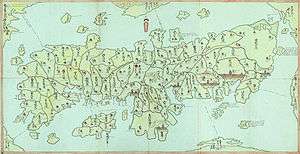Tsuwano Domain
The remains of Tsuwano Castle
The Tsuwano Domain (津和野藩 Tsuwano-han) was a Japanese domain of the Edo period. It was associated with Iwami Province in modern-day Shimane Prefecture.[1]
In the han system, Tsuwano was a political and economic abstraction based on periodic cadastral surveys and projected agricultural yields.[2] In other words, the domain was defined in terms of kokudaka, not land area.[3] This was different from the feudalism of the West.
History
The Meiji-era author Mori Ōgai was the son of a Tsuwano retainer.
List of daimyo
The hereditary daimyo were head of the clan and head of the domain.
- Kamei clan, 1617-1868 (tozama; 43,000 koku)[4]
- Kamei Masanori[4]
- Kamei Koremasa
- Kamei Korechika
- Kamei Koremitsu
- Kamei Korenobu
- Kamei Koretane
- Kamei Norisada
- Kamei Norikata
- Kamei Korenao
- Kamei Korekata
- Kamei Koremi
See also
References

- 1 2 "Iwami Province" at JapaneseCastleExplorer.com; retrieved 2013-4-23.
- ↑ Mass, Jeffrey P. and William B. Hauser. (1987). The Bakufu in Japanese History, p. 150.
- ↑ Elison, George and Bardwell L. Smith (1987). Warlords, Artists, & Commoners: Japan in the Sixteenth Century, p. 18.
- 1 2 Papinot, Jacques Edmond Joseph. (1906). Dictionnaire d’histoire et de géographie du Japon; Papinot, (2003). "Kamei" at Nobiliare du Japon, p. 19 [PDF 23 of 80]; retrieved 2013-4-25.
External links
- "Tsuwano" at Edo 300 (Japanese)
This article is issued from Wikipedia - version of the 10/20/2016. The text is available under the Creative Commons Attribution/Share Alike but additional terms may apply for the media files.